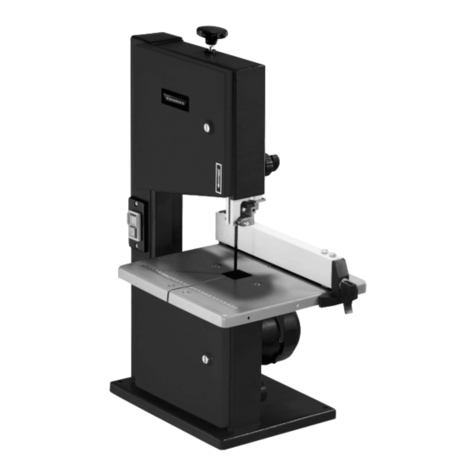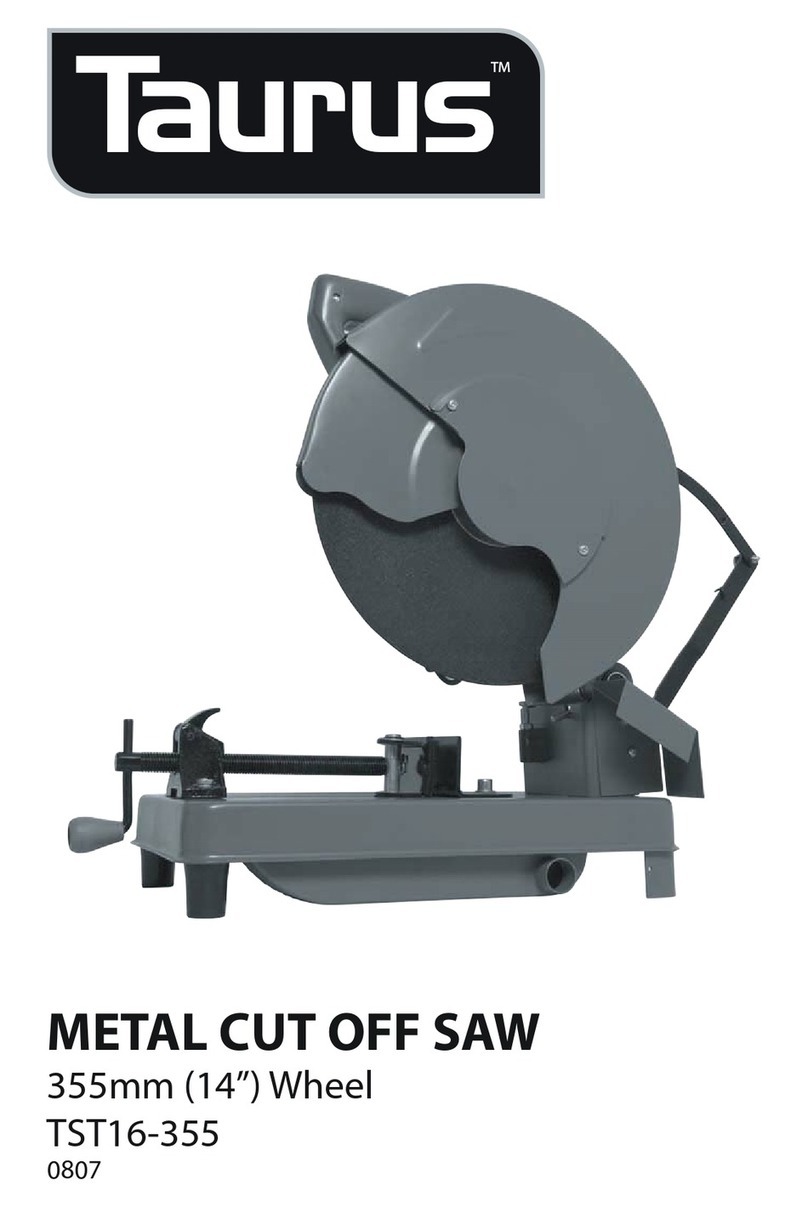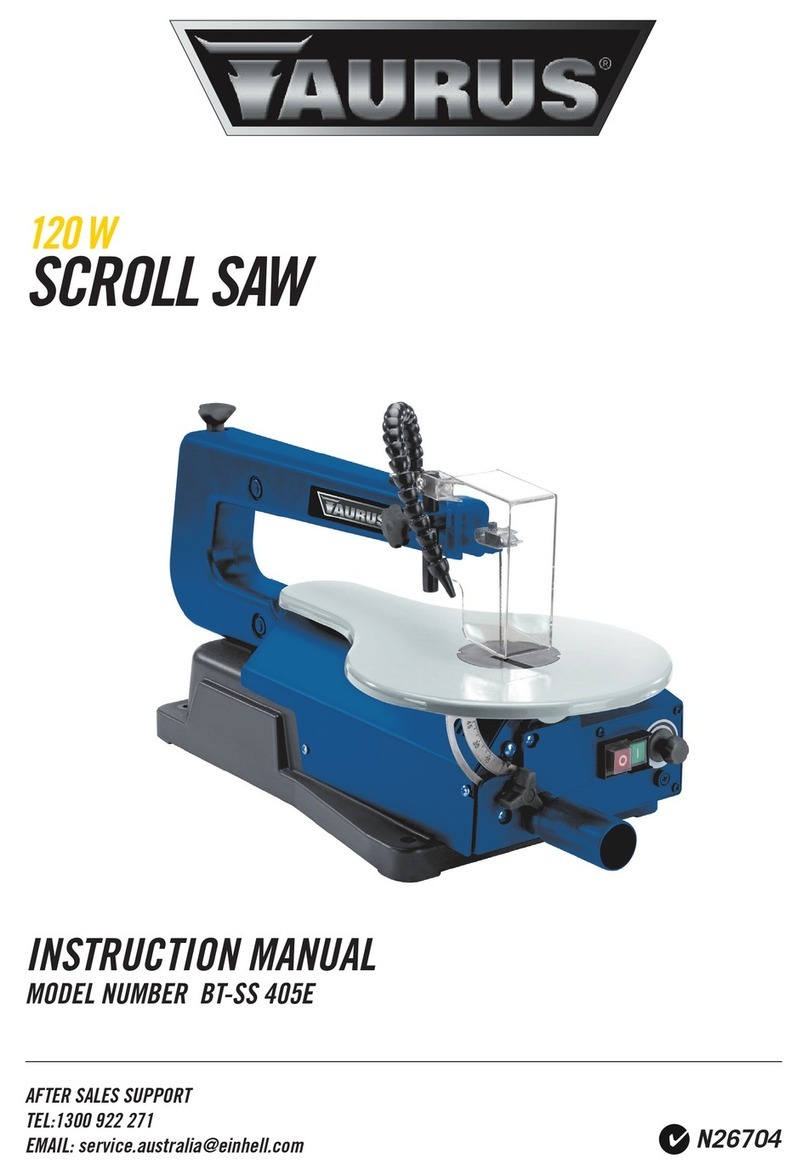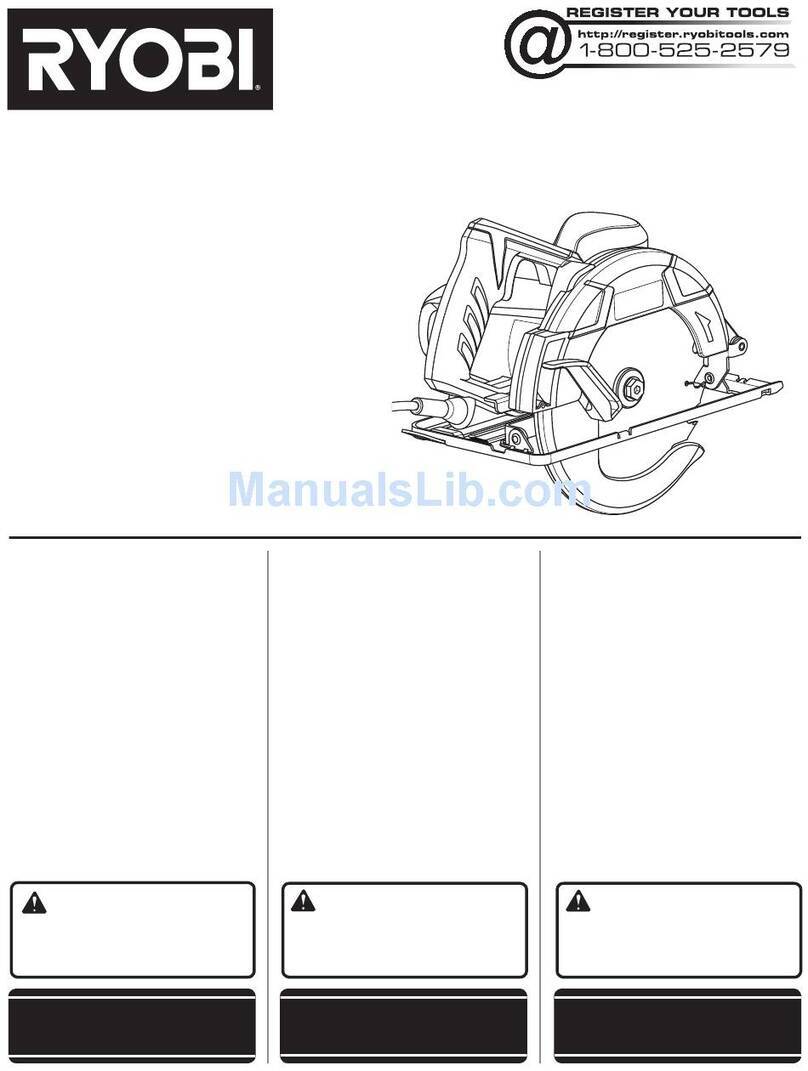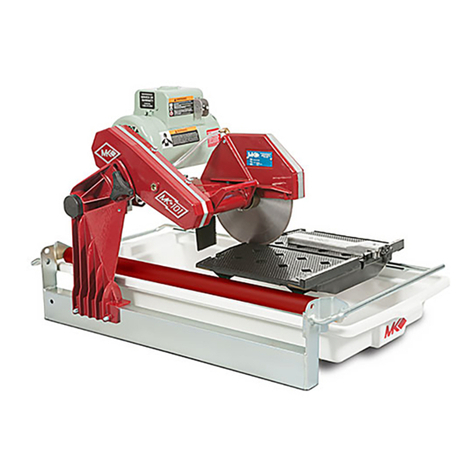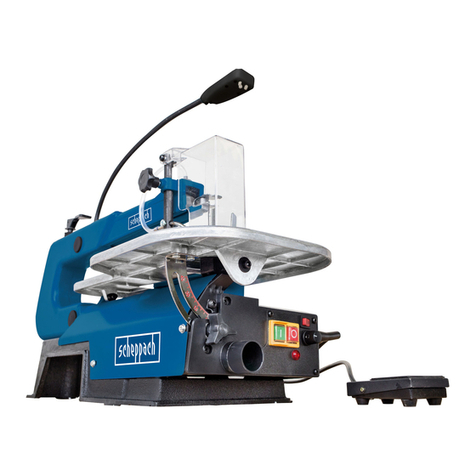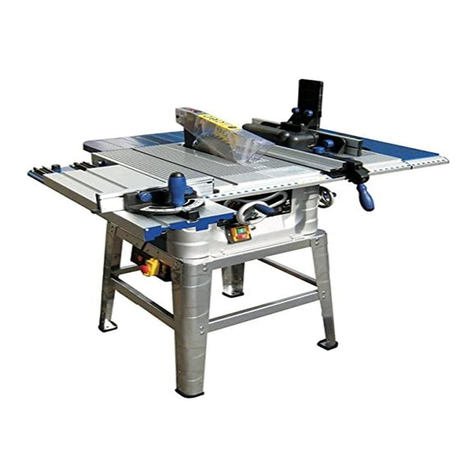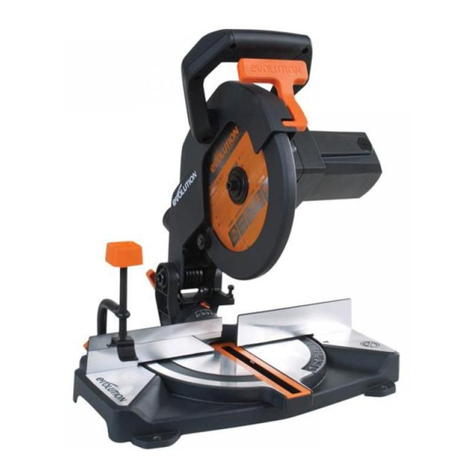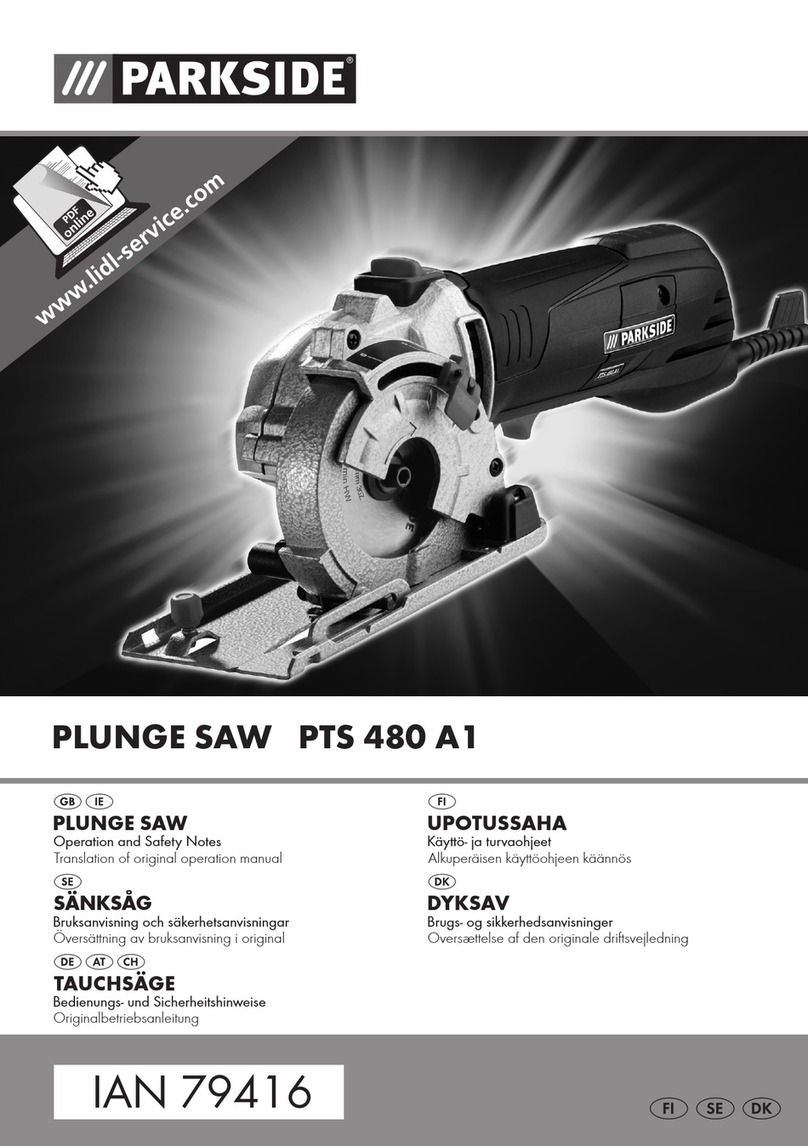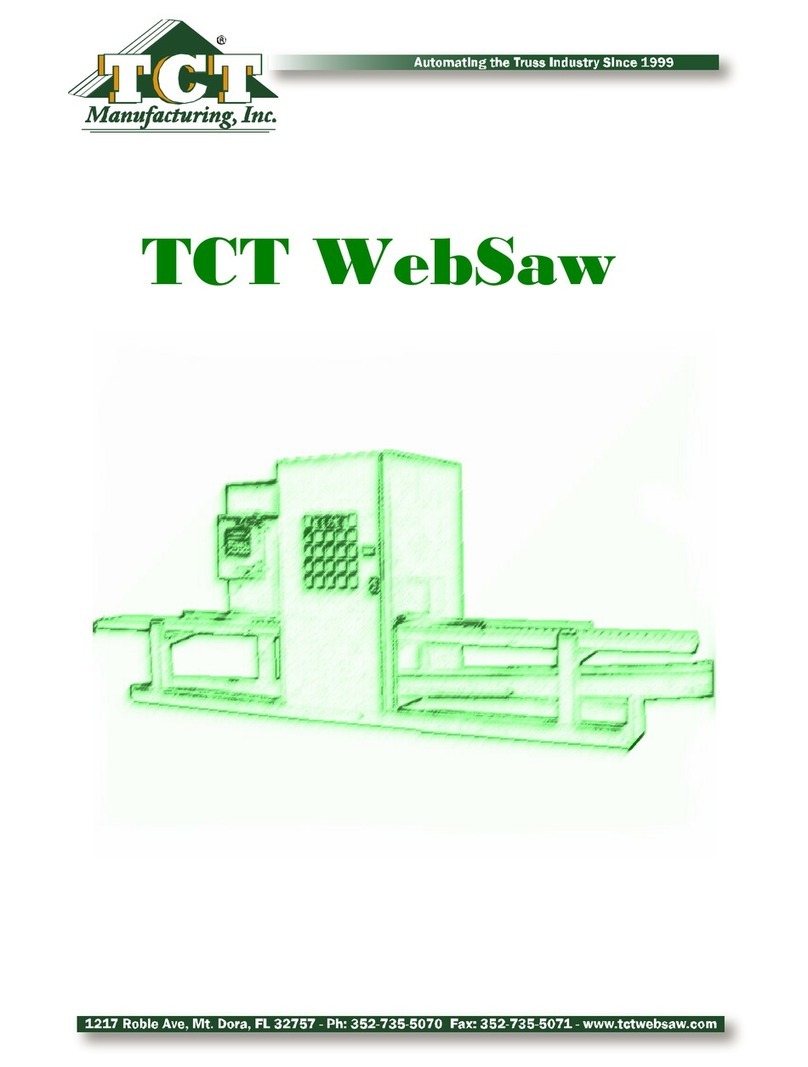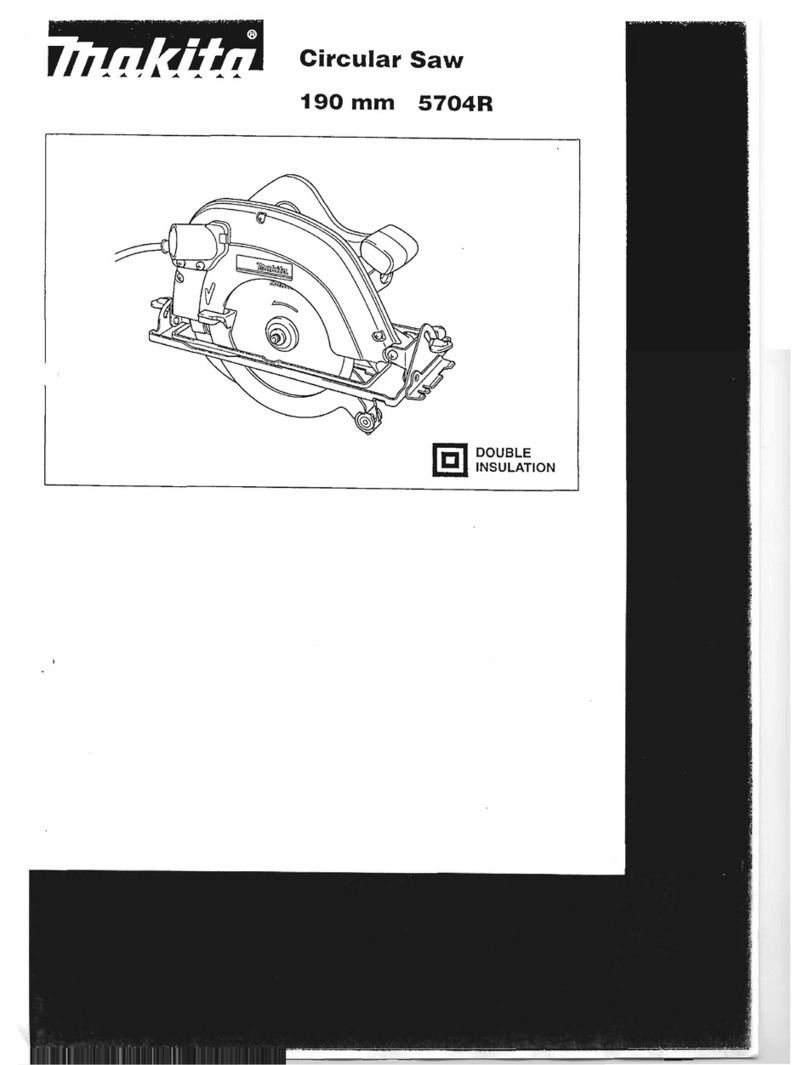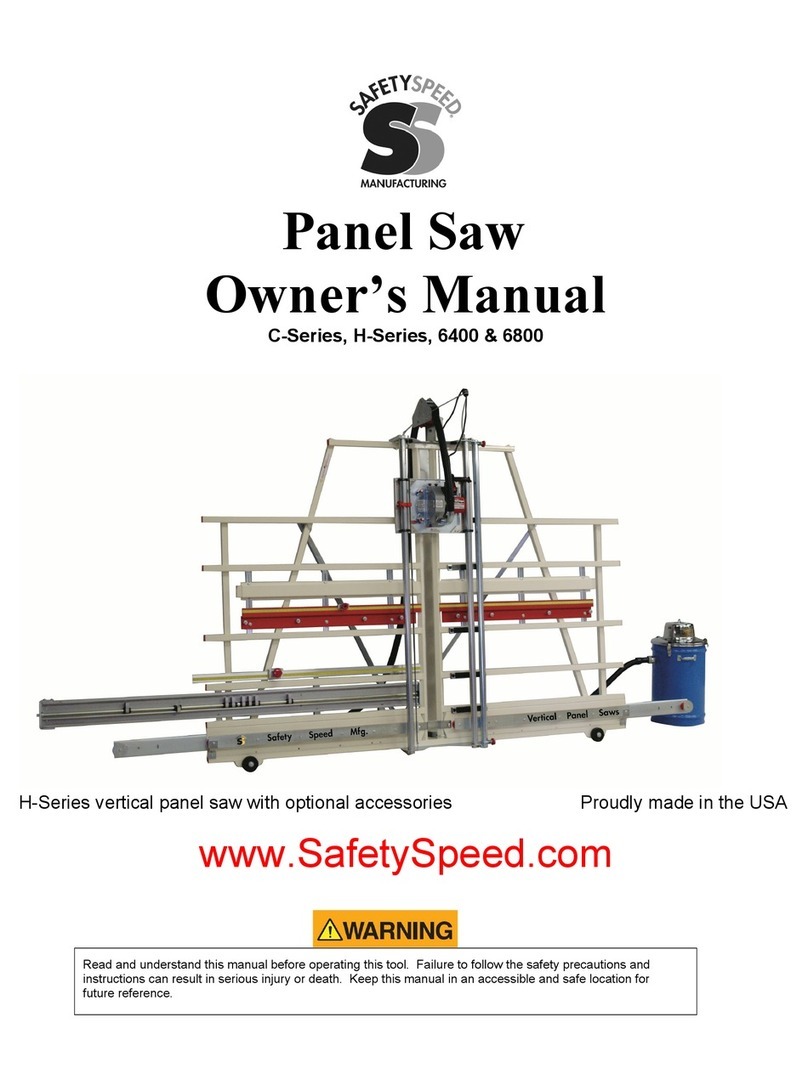Taurus bt-mc 355 User manual

N26704
2100W
METAL CUT OFF SAW
INSTRUCTION MANUAL
AFTER SALES SUPPORT
TEL: 1300 922 271
EMAIL: [email protected]
MODEL NUMBER BT-MC 355

Metal Cut O Saw
What your 1year warranty means
Great care has gone into the manufacture of this product and it should therefore provide you with years
of good service when used properly. In the event of product failure within its intended use over the
once it has been brought to our attention. In the unlikely event of such an occurrence, or if you require
any information about the product, please contact us via our after sales support services, details of
which can be found in this manual and on the product itself.
Welcome Section
Congratulations on choosing to buy a TAURUS® product.
All products brought to you by TAURUS® are manufactured to the highest standards of performance and
safety, and, as part of our philosophy of customer service and satisfaction, are backed by our
comprehensive 1Year Warranty.
We hope you will enjoy using your purchase for many years to come.
Table of Contents
1. General Safety Rules Pg. 4
Special Saftey Rules Pg. 5
Layout Pg. 6
Items Supplied Pg. 7
Proper Use Pg. 7
Technical Data Pg. 7
Before putting the Machine into Operation Pg. 7
Assembly Pg. 8
Using the Cut O Saw Pg. 8
Maintenance Pg. 9
Ordering Spare Parts Pg. 9
2.
3.
4.
5.
6.
7.
8.
9.
10.
11.
After Sales Support EMAIL: service.australia@einhell.comTEL: 1300 922 271
1

1
4
2 b 10
9
2 3
16 11
5
8
7
5
6
14
6
1
3
7
2
b
15
13
17
12
a
15
4
After Sales Support EMAIL: service.australia@einhell.comTEL: 1300 922 271
2

5
6
8
1
16
7
4
15
17
4
19 18
13
7
3
20
21
11
24
9
11
23
24
22
7
10
b
9
1
11
10
15
221
9
After Sales Support EMAIL: service.australia@einhell.comTEL: 1300 922 271
3

After Sales Support EMAIL: service.australia@einhell.comTEL: 1300 922 271
d. Remove any adjusting key or wrench before
turning the power tool on. A wrench or a key left
attached to rotating part of the power tool may
result in personal injury.
e. Do not overreach. Keep proper footing and
balance at all times. This enables better control
of the power tool in unexpected situations.
f. Dress properly. Do not wear loose clothing or
jewellery. Keep your hair, clothing and gloves
away from moving parts. Loose clothes,
jewellery or long hair can be caught in moving
parts.
g. If devices are provided for the connection of
dust extraction and collection facilities, ensure
these are connected and properly used. Use of
these devices can reduce dust-related hazards.
4. Power tool use and care
a. Do not force the power tool. Use the correct
power tool for your application. The correct
power tool will do the job better and safer at the
rate for which it was designed.
b. Do not use the power tool if the switch does not
turn it on and o. Any power tool that cannot be
controlled with the switch is dangerous and must
be repaired.
c. Disconnect the plug from the power source
and/ or the battery pack from the power tool
before making any adjustments, changing
accessories, or storing power tools. Such
preventive safety measures reduce the risk
of starting the power tool accidentally.
d. Store idle power tools out of the reach of
children and do not allow persons unfamiliar
with the power tool or these instructions to
operate the power tool. Power tools are
dangerous in the hands of untrained users.
e. Maintain power tools. Check for misalignment
or binding of moving parts, breakage of parts
and any other condition that may aect the
power tools operation. If damaged, have the
power tool repaired before use. Many accidents
are caused by poorly maintained power tools.
f. Keep cutting tools sharp and clean. Properly
maintained cutting tools with sharp cutting
edges are less likely to bind and are easier to
control.
g. Use the power tool, accessories and tool bits
etc. in accordance with these instructions and
in the manner intended for the particular type
of power tool, taking into account the working
conditions and the work to be performed. Use
of the power tool for operations dierent from
those intended could result in a hazardous
situation.
5. Service
a. Have your power tool serviced by a qualied
repair person using only identical replacement
parts. This will ensure that the safety of the power
tool is maintained.
6. Recommendation
We recommend that the tool always be supplied
via a residual current device with a rated residual
current of 30mA or less.
1. GENERAL SAFETY RULES
WARNING! Read all instructions Failure to
follow all instructions listed below may result
in electric shock, re and/or serious injury. The
term ’’power tool’’ in all of the warnings listed
below refers to your mains-operated (corded)
power tool or battery-operated (cordless) power
tool.
SAVE THESE INSTRUCTIONS
1.Work area
a. Keep work area clean and well lit. Cluttered and
dark areas invite accidents.
b. Do not operate power tools in explosive
atmospheres, such as in the presence of
ammable liquids, gases or dust. Power tools
create sparks which may ignite the dust or fumes.
c. Keep children and bystanders away while
operating a power tool. Distractions can cause
you to lose control.
2. Electrical safety
a. Power tools plugs must match the outlet.
Never modify the plug in any way. Do not use
any adapter plugs with earthed (grounded)
power tool. Unmodied plugs and matching
outlets will reduce risk of electric shock.
b. Avoid body contact with earthed or grounded
surfaces such as pipes, radiators, ranges and
refrigerators. There is an increased risk of electric
shock if your body is earthed or grounded.
c. Do not expose power tools to rain or wet
conditions. Water entering a power tool will
increase the risk of electric shock.
d. Do not abuse the cord. Never use the cord
for carrying, pulling or unplugging the power
tool. Keep cord away from heat, oil, sharp edges
or moving parts. Damaged or entangled cords
increase the risk of electric shock.
e. When operating a power tool outdoors, use an
extension cord suitable for outdoor use. Use of
a cord suitable for outdoor use reduces the risk
of electric shock.
3. Personal safety
a. Stay alert, watch what you are doing and use
common sense when operating a power tool.
Do not use a power tool while you are tired or
under the inuence of drugs, alcohol or
medication. A moment of inattention while
operating power tools may result in serious
personal injury.
b. Use safety equipment. Always wear eye
protection. Safety equipment such as dust
mask, non-skid safety shoes, hard hat, or hearing
protection used for appropriate conditions will
reduce personal injuries.
c. Avoid accidental starting. Ensure the switch is in
the o-position before plugging in. Carrying
power tools with your nger on the switch or
plugging in power tools that have the switch
on invites accidents.
4

After Sales Support EMAIL: service.australia@einhell.comTEL: 1300 922 271
2. SPECIAL SAFETY RULES
1. For your own safety, read these safety instructions before
you put the electric tool into operation. Familiarize yourself
with the tools operating range and limits, as well as the
special hazards involved in its operation.
2. Do not remove any safety devices.
3. Avoid hazardous ambient conditions. Never use electric
tools in damp or wet locations, and never expose them
to rain. Keep your work area clean. Ensure that there is
sucient space at your place of work.
4. Make the machine child-proof. Fit a pad-lock, deactivate
the main switch or remove the
start key.
5. Do not overload your electric tool. Electric tools work
better and safer when used within their quoted capacity
range.
6. Secure your workpiece. Use clamps or a vice to hold the
workpiece securely. This is safer than using your hand.
7. Take care of your electric tools. Keep mounted
attachments such as cut-o wheels, blades and bits sharp
and clean to enable you to work well and safely. Follow the
maintenance regulations and the instructions for changing
mounted attachments such as cut-o wheels, blades
and bits. Check the electric tool’s cable regularly and
have it replaced by an authorized specialist if damaged.
Check your extension cables regularly and replace them if
damaged. Keep handles dry and free from oil and grease.
8. Do not climb on your electric tool. The tool may topple and
cause an injury.
9. Check the electric tool for damage. Each time before
reusing the electric tool, carefully check that the safety
devices or any slightly damaged parts are working as
intended. Check that the moving parts are in good
working order, that they do not jam, and that no parts are
damaged. All parts must be correctly assembled and meet
all the conditions required to ensure that the electric tool
works correctly. Unless otherwise stated in the operating
instructions, damaged safety devices and parts have to
be repaired or replaced by an authorized service center.
Have damaged switches replaced by a customer service
workshop.
10. Direction of operation: Make sure that the direction arrow
points toward the workpiece.
11. Never leave an electric tool unattended when it is running.
Always switch o your electric tool before leaving it. Wait
until the tool stops moving completely.
12. Connect your electric tool to earth. An electric tool with
a PE conductor may only be connected to a matching
socket-outlet.
13. Keep your electric tools in a safe place. When equipment is
not being used it should be kept in a dry, closed place out
of children’s reach.
14. Connect up a dust extraction system. If there are provisions
for connecting up a dust extraction and collection system,
make sure that such a system is connected and in use.
15. CAUTION! The use of mounted attachments and
accessories other than those intended may put you at risk
of injury.
16. Do not lose these safety regulations.
17. CAUTION! Never use your cut-o machine unless it is
fully assembled and installed as described in this manual.
If you are not acquainted with the use of a cut-o machine,
get advice from a supervisor, trainer or other qualied
person.
18. Wear safety goggles, a visor, a breathing mask, an apron,
safety shoes, long tight sleeves and gloves.
19. Use only recommended, reinforced cut-o wheels.
20. Securely tighten the shaft screw and all clamps before
beginning your work.
21. Make sure that the shaft lock is released before starting.
22. Always leave the safety devices in position and make sure
that they are in good working order.
23. Keep your hands away from the cut-o wheel.
24. Secure the workpiece carefully. It has to be securely
clamped in a straight position in order to prevent it from
moving and skewing while the cut is being made.
25. Never cut free-handed.
26. Never reach behind or near the cut-o wheel.
27. Make sure that the cut-o wheel stops completely before
you remove the workpiece, clamp in a new workpiece, or
adjust the angle.
28. Make sure that there are no foreign bodies on the cut-o
wheel and ange.
29. When you t a cut-o wheel, take care to tighten the
shaft screw just enough to hold the wheel in place and
prevent it from spinning. Overtightening the shaft screw
may damage the cut-o wheel or cause it to break o the
wheel ange.
30. Use only recommended cut-o wheels that are suitable for
3800/min or higher and are marked accordingly.
31. Always check the cut-o wheel for cracks or other signs
of damage. Replace cracked or damaged cut-o wheels
immediately.
32. Use only the cut-o wheel anges specied for your
machine.
33. Before you switch on, make sure that the cut-o wheel
does not touch the machine.
5

After Sales Support EMAIL: service.australia@einhell.comTEL: 1300 922 271
34. Allow the motor to reach top speed before you begin to
cut.
35. After you have switched on, lower the cut-o wheel slowly
until it comes into contact with the workpiece. Then carry
out a smooth cut. Avoid causing the cut-o wheel to jump
or chatter.
36. This will only lead to premature wear and result in poor
cuts or a broken cut-o wheel.
37. Workpieces are best cut when their angle in relation to the
cut-o wheel is kept as small a possible.
38. The number of cuts per cut-o wheel and their quality may
vary considerably with the time taken to make the cuts.
Fast cuts may accelerate wheel wear, but they also prevent
discoloring of the workpiece and the formation of burr.
This requires particular attention when cutting thinwalled
tubes. Do not reduce the cutting speed toward the end of
the cut, but cut right through to the end with full power.
This will help to prevent the material from overheating and
forming burr.
39. Always use the guard over cut-o wheel.
40. Never use the machine in the vicinity of combustible
liquids or gases.
41. To avoid electric shocks, never use the machine in damp or
wet locations, and never expose it to rain.
42. This electric tool was developed exclusively for cutting
ferrous metals. Do not try to cut wood, brick or magnesium
on this machine.
43. Do not stand in the cutting direction after a new cut-o
wheel has been tted. Allow the machine to run for
approximately one minute before you begin with the
cutting. If the cutting- o wheel has an invisible fracture or
defect, it will burst in less than one minute.
44. Switch o the power supply before you carry out any
maintenance or adjustment work on the machine.
45. Should any part of your machine be missing, damaged
or out of order in any way, or should any electrical
components fail to work correctly, switch o the machine
and pull the power plug out of the socket-outlet. Replace
the missing, damaged or defective part before you carry
on with your work.
46. In the case of cut-o wheels with straightsided anges, be
sure to observe the recommend values for thickness and
hole diameter.
Wear ear-mus.
The impact of noise can cause
damage to hearing.
Wear a breathing mask.
Dust which is injurious to health can be generated
when working on wood and other materials. Never
use the device to work on any materials containing
asbestos!
Wear safety goggles.
Sparks generated during working or splinters,
chips and dust emitted by the device can cause
loss of sight.
Important!
When using equipment, a few safety precautions must be
observed to avoid injuries and damage.
Please read the complete operating manual with due care.
Keep this manual in a safe place, so that the information is
available at all times. If you give the equipment to any other
person, give them these operating instructions as well.
We accept no liability for damage or accidents which arise
due to non-observance of these instructions and the safety
information.
3. LAYOUT (FIG. 1/2)
1. Saw head
2. Handle
3. Adjustable guard for the cut-o wheel
4. Adjustable clamping face
5. Spindle
6. Hand crank
7. Stationary clamping face
8. Carry handle
9. Shaft lock
10. ON/OFF switch
11. Cut-o wheel
12. Table
13. Locking device
14. Overload switch
15. Vice
16. Lock screw
17. Lock screw
b. Safety lock
6

After Sales Support EMAIL: service.australia@einhell.comTEL: 1300 922 271
4. ITEMS SUPPLIED
• Metal cut-o saw
• 2x Cut-o wheel
• Open-ended wrench
• Instruction Manual
• Quick Start Guide
• Warranty Card and Details
• Warranty Sticker
5. PROPER USE
The metal cut-o machine is designed for cutting metal
commensurate with the machine’s size.
The machine is to be used only for its prescribed purpose.
Any other use is deemed to be a case of misuse.
The user/operator and not the manufacturer will be held liable
for damage and/or injuries of any kind that result from such
misuse.
The machine is to be operated only with suitable cut-o
wheels. It is prohibited to use any kind of saw blade made of
HSS, HM, CV, etc.
To use the machine properly you must also observe the safety
regulations, the assembly instructions and the operating
instructions to be found in this manual.
All persons who use and service the machine have to be
acquainted with this manual and must be informed about the
machine’s potential hazards.
It is also imperative to observe the accident prevention
regulations in force in your area.
The same applies for the general rules of occupational health
and safety.
The manufacturer shall not be liable for any changes made to
the machine nor for any damage resulting from such changes.
Even when the machine is used as prescribed it is still
impossible to eliminate certain residual risk factors. The
following hazards may arise in connection with the machine’s
construction and design:
• Contact with the cut-o wheel in the uncovered cutting
zone.
• Reaching into the cut-o wheel while it is running (injuries
through cutting).
• Kick-back of workpieces and parts of workpieces.
• Broken cut-o wheels.
• Catapulting of damaged or cut-o wheels.
• Damage to hearing if ear-mus are not used as necessary.
6. TECHNICAL DATA
AC motor 240 V ~ 50 Hz
Power P 2100 W
Idle speed n03800 min-1
Cut-o wheel Ø 355 x Ø 25.4 x 3.2 mm
Footprint 480 x 277 mm
Swiveling range 0 - 45°
Vice clamping range max. 195 mm
Saw width at 90° Ø 70 / 105 x 45 mm
Saw width at 45° 85 x 45 mm
Weight 17.5 kg
Sound and vibration
Sound and vibration values were measured in accordance with
EN 61029.
LpA sound pressure level 101 dB(A)
KpA uncertainty 3 dB
LWA sound power level 114 dB(A)
KWA uncertainty 3 dB
Important!
The vibration value changes according to the area of
application of the electric tool and may exceed the specied
value in exceptional circumstances.
Keep the noise emissions and vibrations to a minimum.
Only use appliances which are in perfect working order.
Service and clean the appliance regularly.
Adapt your working style to suit the appliance.
Do not overload the appliance.
Have the appliance serviced whenever necessary.
Switch the appliance o when it is not in use.
Wear protective gloves.
7. BEFORE PUTTING THE
MACHINE INTO OPERATION
• Unpack the metal cut-o machine and check it for damage
which may have occurred in transit.
• The machine has to be set up where it can stand rmly, e.g.
on a work bench, or it must be bolted to a strong base.
• All covers and safety devices have to be properly tted
before the machine is switched on.
• It must be possible for the cut-o wheel to run freely.
• Before you actuate the ON/OFF switch, make sure that
the cut-o wheel is correctly tted and that the machine’s
moving parts run smoothly.
• Before you connect the machine to the power supply,
make sure the data on the rating plate is the same as that
for your mains.
7

After Sales Support EMAIL: service.australia@einhell.comTEL: 1300 922 271
• Release the (g.2/Item 13) locking device.
8. ASSEMBLY
Important. Always pull out the power plug before
carrying out maintenance, resetting or
assembly work.
8.1 Transport brace / carry-handle (Fig. 1 / 2)
• Push saw head (1) down with the handle (2) and pull out
the locking device (13).
• Slowly raise the saw head (1).
Caution! The resetting spring lifts the saw head (1)
automatically. Therefore, do not simply let go of the handle
(2) after cutting, but allow the saw head (1) to rise slowly
by applying slight counterpressure.
• Fig.1 shows the saw head (1) in its upper position.
• For transporting, the saw head (1) should be locked in the
lower position with the locking device (13).
• The saw is equipped with a carry-handle (8) to make it
easier to transport.
8.2 Vice (Fig. 3)
Every workpiece has to be fastened in the vice (15) before it
is cut.
• Flip up the top half of the nut (a).
• Pull out the spindle (5) far enough for the workpiece to be
clamped between the clamping faces (4/7) of the vice (15).
Note: You do not have to turn the spindle (5)when the
top half of the nut (a) has been ipped up. The spindle
(5) can be pulled out or pushed in to the exact amount
required.
• Push forward the spindle (5) to the point where the
clamping face (4) touches the workpiece.
• Flip down the top half of the nut (a) again so that the
spindle (5) and both halves of the nut engage with each
other.
• Turn the hand crank (6) to safely secure the workpiece in
the vice (15).
8.3 Mitre cuts (Fig. 4)
The vice (15) can be swiveled from 0° to 45° in order to make
mitre cuts.
• Slacken the two screws (16/17).
• Turn the clamping face (7) of the vice (15) to the required
angle.
• Retighten the screws (16/17).
• When you clamp the workpiece, the front clamping face
(4) will automatically swing into the correct position and
align itself with the workpiece in order to ensure that the
workpiece is safely fastened.
8.4 Adjusting the stop screw (Fig. 5)
The downward movement of the cut-o wheel can be
adjusted with the stop screw (18).
This is necessary to compensate wheel wear—as the cut-o
wheel becomes smaller in diameter it would no longer be able
to cut right through the workpiece.
• Undo the lock nut (19).
• Turn the stop screw (18) in or out as required.
• Lower the saw head (1) to check whether the cut-o wheel
(11) reaches the clamping face (7) of the vice (15 ).
• Retighten the lock nut (19).
8.5 Replacing the cut-o wheel (Fig. 6 / 7/8)
• Pull out the power plug.
• Move the saw head (1) to its upper position of rest.
• Swing up the adjustable guard (3) for the cut-o wheel
and hook it in place.
• Open the wing nut (20) and turn the side guard (21) for the
cut-o wheel to the rear.
• Push the shaft lock (9) to the right and turn the cut-o
wheel (11) slowly with the other hand until the shaft lock
(9) engages.
• Use the supplied open-ended wrench (23) to turn out the
shaft screw (22) in counterclockwise direction.
• Remove the shaft screw (22), washer, outer ange (24) and
worn cut-o wheel (11).
• Install the new cut-o wheel in reverse order and tighten.
• Important! The anges have to be thoroughly cleaned
prior to mounting the cut-o wheel.
• Note the direction arrow!
• Use only recommended, reinforced cut-o wheels and
take care to tighten the shaft screw (22) just enough to
hold the wheel (11) securely in place and prevent it from
spinning.
Overtightening the shaft screw (22) may damage the
cut-o wheel.
• Turn the side guard (21) for the cut-o wheel back to the
front and fasten in place with the thumb screw (20).
• Unhook the guard for the cut-o wheel, so that the
adjustable guard (3) can be ipped forward again.
9. USING THE CUT OFF SAW
9.1 ON/OFF switch (Fig. 8)
• Press the safety lock (b), then press the ON/OFF switch (10)
to turn on the saw. Keep the ON/OFF switch (10) pressed
while you are sawing.
• To deactivate the cut-o machine again, let go of the ON/
OFF switch (10).
9.2 Overload cut-out (Fig. 2)
The motor is protected against overload by an overload cut-
out (14). If the rated current is exceeded, the overload cut-out
(14) switches the appliance o. After a short cooling-o
8

After Sales Support EMAIL: service.australia@einhell.comTEL: 1300 922 271
phase, the appliance can be switched back on by pressing the
overload switch (14)
9.3 Making a cut (Fig. 9)
• Clamp the workpiece securely in the vice (15).
• Switch on the machine and wait for the motor to reach its
top speed.
• Push down the saw head by the handle (2) until the cut-o
wheel (11) makes slight contact with the workpiece.
• Move the cut-o wheel (11) smoothly through the material
you want to cut.
Important! Avoid causing the cut-o wheel to jump
or chatter. This will only result in cuts of poor quality or a
broken wheel.
• Press down the handle (2) rmly and evenly during
the cutting operation. To prevent overheating of the
workpiece and excessive formation of burr, you should not
reduce cutting speed at the end of the cutting operation.
Note: The number of cuts per cut-o wheel and their
quality may vary considerably with the time taken to make
the cuts. Fast cuts may accelerate wheel wear, but they also
prevent discoloring of the workpiece and the formation
of burr.
10.MAINTENANCE
• Caution! Pull out the power plug rst.
• Remove dust and dirt regularly from the machine.
Cleaning is best carried out with a ne brush or a cloth.
• Never use caustic agents to clean plastic parts.
11.ORDERING SPARE PARTS
Contact the After Sales Support on 1300 922 271 and quote
the following data when ordering spare parts:
• Type of machine
• Article number of the machine
• Identication number of the machine
• Spare part number of the part required
9

After Sales Support EMAIL: service.australia@einhell.comTEL: 1300 922 271
10

After Sales Support EMAIL: service.australia@einhell.comTEL: 1300 922 271
08/2012
45.031.29_11012(01)
11
Table of contents
Other Taurus Saw manuals
